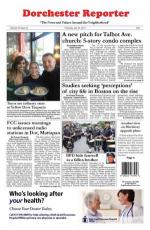June 12, 2014
Come September, most seventh and eighth graders who attend Boston Public Schools (BPS) will swap a round-trip ride on a yellow city school bus for a student Charlie Card and a journey on the MBTA. The switch — approved this month by the School Committee— is not sitting well with some parents, according to news reports.
RELATED: BNN-TV reports on the BPS plan and the push-back
The move makes both social and economic sense, say Boston Public Schools officials. It will allow for an additional 4,600 students to have greater freedom to travel to and from school outside the constraints of a yellow bus schedule, on top of the 1,800 or so seventh and eighth graders who previously opted into the program; and it will get them to school faster. Financially, the shift will save BPS $11 million annually.
Some parents, however, still aren’t sold on the plan and want the mayor and school system to reconsider.
“It is very disconcerting to hear that the budget comes before the children,” said Nicole Manny whose 12-year-old daughter is entering Boston Latin School in the fall. Manny said the transportation switch has made her rethink the school choice, which will have her daughter commuting to the Latin School from Ashmont Station. “It’s very frustrating to know that she is on the public bus and they’re putting in Plexiglass to keep the drivers safe,” she said.
To address such parental concerns, BPS officials, school leaders, and community members have taken to walking along the routes students would use after school to identify and address possible problem areas. The walks are being done at every school in the city with seventh and eighth graders through the end of the school year.
A recent walking tour from the Lilla G. Frederick Pilot Middle School on Columbia Road revealed potential safety hazards for students such as crossing Columbia Road and walking by a liquor store at a particular corner near the school. Both situations could be covered by crossing guards, said Kimberly Rice, the school department’s chief operating officer.
“Down in the corner, where a number of adults hang out near the liquor store, we’re talking of putting a crossing guard which would work as a positive influence” for the 12-14 year-olds, Rice said.
These walking tours are being done at every school in the city with seventh and eighth graders through the end of the school year.
“The walking assessment has been the most enlightening to physically be out in the neighborhoods and walking around and being able to differentiate what where kids are going on their way home,” Rice said.
“A lot of this planning was initially done with maps and routing software so to actually get out there and see how the traffic goes has really, really been enlightening, especially when we’re talking about one area over the other.”
More than anything, Rice said officials’ approach has to vary with different schools, whether it’s by deploying more crossing guards at busy intersections, fixing up sidewalks and bus stops in more remote school locations, or developing shuttle service between MBTA hubs and distant schools.
Officials are also working to create “actionable items” out of parents’ issues with the changes, in the hopes that BPS can resolve the issues.
Creating shuttle busses between the school and an MBTA hub such as a train station is one such solution. Rice said Boston Latin families had asked for a shuttle between the school and a community location rather than an MBTA hub for safety concerns.
“We don’t want to create any undue hardships,” Rice said.
In mapping out potential new routes for students, BPS found some students would have a potential commute of more than an hour or involving three or more transfers between bus and train lines, Rice said. Those 175 seventh and eighth graders will still receive yellow bus service.
Students who also receive yellow bus service through an individual education plan will also still be provided with BPS bus service.
Once students are in school this fall, said Transit Police Chief Paul MacMillan, his officers will be working with students in the schools to make sure they understand their responsibilities on the T. “We hope to get into the schools early-on in the school year to give training to students on proper behavior on the MBTA,” MacMillan said. “We’re working with the MBTA general manager’s office to make it happen. We’ll talk to students about their rides on the MBTA, talking of expectations by the T, and the T’s expectation of them.”
“We have done some training before with students but it was not as focused as it will be,” he said. MacMillan anticipates few problems with the change. His team is not planning to step up action on routes with increased students ahead of the start of the school year. “We’ll wait and judge how the school year starts out,” he said. “Bottom line: We’ve done a lot of pre-planning relative to this issue and we anticipate a smooth transition. But should anything come up, we’ll be prepared to handle it.”
Topics:



